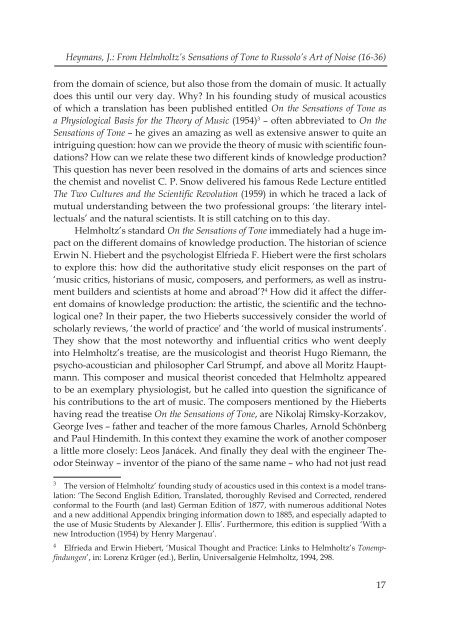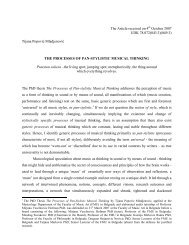John Heymans1 FROM HELMHOLTZ'S SENSATIONS ... - New Sound
John Heymans1 FROM HELMHOLTZ'S SENSATIONS ... - New Sound
John Heymans1 FROM HELMHOLTZ'S SENSATIONS ... - New Sound
You also want an ePaper? Increase the reach of your titles
YUMPU automatically turns print PDFs into web optimized ePapers that Google loves.
Heymans, J.: From Helmholtz’s Sensations of Tone to Russolo’s Art of Noise (16-36)<br />
from the domain of science, but also those from the domain of music. It actually<br />
does this until our very day. Why? In his founding study of musical acoustics<br />
of which a translation has been published entitled On the Sensations of Tone as<br />
a Physiological Basis for the Theory of Music (1954) 3 – often abbreviated to On the<br />
Sensations of Tone – he gives an amazing as well as extensive answer to quite an<br />
intriguing question: how can we provide the theory of music with scientifi c foundations?<br />
How can we relate these two different kinds of knowledge production?<br />
This question has never been resolved in the domains of arts and sciences since<br />
the chemist and novelist C. P. Snow delivered his famous Rede Lecture entitled<br />
The Two Cultures and the Scientifi c Revolution (1959) in which he traced a lack of<br />
mutual understanding between the two professional groups: ‘the literary intellectuals’<br />
and the natural scientists. It is still catching on to this day.<br />
Helmholtz’s standard On the Sensations of Tone immediately had a huge impact<br />
on the different domains of knowledge production. The historian of science<br />
Erwin N. Hiebert and the psychologist Elfrieda F. Hiebert were the fi rst scholars<br />
to explore this: how did the authoritative study elicit responses on the part of<br />
‘music critics, historians of music, composers, and performers, as well as instrument<br />
builders and scientists at home and abroad’? 4 How did it affect the different<br />
domains of knowledge production: the artistic, the scientifi c and the technological<br />
one? In their paper, the two Hieberts successively consider the world of<br />
scholarly reviews, ‘the world of practice’ and ‘the world of musical instruments’.<br />
They show that the most noteworthy and infl uential critics who went deeply<br />
into Helmholtz’s treatise, are the musicologist and theorist Hugo Riemann, the<br />
psycho-acoustician and philosopher Carl Strumpf, and above all Moritz Hauptmann.<br />
This composer and musical theorist conceded that Helmholtz appeared<br />
to be an exemplary physiologist, but he called into question the signifi cance of<br />
his contributions to the art of music. The composers mentioned by the Hieberts<br />
having read the treatise On the Sensations of Tone, are Nikolaj Rimsky-Korzakov,<br />
George Ives – father and teacher of the more famous Charles, Arnold Schönberg<br />
and Paul Hindemith. In this context they examine the work of another composer<br />
a little more closely: Leos Janácek. And fi nally they deal with the engineer Theodor<br />
Steinway – inventor of the piano of the same name – who had not just read<br />
3 The version of Helmholtz’ founding study of acoustics used in this context is a model translation:<br />
‘The Second English Edition, Translated, thoroughly Revised and Corrected, rendered<br />
conformal to the Fourth (and last) German Edition of 1877, with numerous additional Notes<br />
and a new additional Appendix bringing information down to 1885, and especially adapted to<br />
the use of Music Students by Alexander J. Ellis’. Furthermore, this edition is supplied ‘With a<br />
new Introduction (1954) by Henry Margenau’.<br />
4 Elfrieda and Erwin Hiebert, ‘Musical Thought and Practice: Links to Helmholtz’s Tonempfi<br />
ndungen’, in: Lorenz Krüger (ed.), Berlin, Universalgenie Helmholtz, 1994, 298.<br />
17



